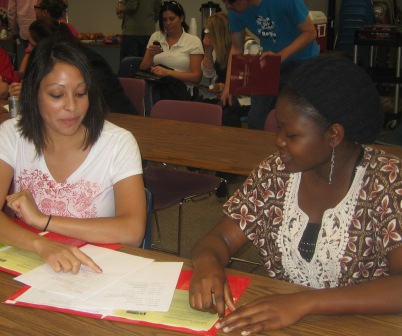|
|
|
Chapter 34. THESIS PAPER
Activities Using
Thesis Argument
See also "Activities
& Groups." ---
SPECIAL ACTIVITIES
-
ROLE PLAYING: In a small group of three or four
people, choose or make up an interesting or controversial
subject. Then imagine an entirely different role for yourself as a group:
pretend, as a group, that you are an individual such as a politician, a
corporation president, or a prominent entertainment figure. Write down
the name of your role and describe it in two or three sentences. Then,
as a group, write an argument from this "person"--this
role--supporting just one side of the subject or issue you chose. Then
pass your paper to another group (or, if you are at a computer terminal,
stand as a group and move to another group's computer terminal). Then imagine
a new role: someone who is from any field or type of discipline you choose,
but this person must be someone who thoroughly opposes the argument in front
of you. Write this new person's argument or disagreement, step by
step. Then read your results aloud to the class.
-
CIRCLE SENTENCING: This activity provides
interesting, fun practice of the basic thesis format. It can be varied
to provide practice of adding supporting facts and quotations, as well.
(a) Everyone should get out a sheet of blank, lined paper and number
the first line "1.," then after it write Some people would argue that _______"
and then fill in the line with an interesting argument or opinion, serious or
silly.
(b) Then everyone should pass his/her piece of paper to the left, and
on the new piece of paper in front of her, write "2." in the next line.
Then she should fill in the "2." line with the phrase, "The first reason this
is true is that ____." And then she should fill in the blank with a
logical reason why the statement in "1." is true.
(c) Then everyone should pass the paper again, and on the new piece of
paper, under "2.," write "3. The second reason this is true is that ____."
Then she should fill in the blank with a second logical reason why the
statement in "1." is true.
(d) Then everyone should pass the paper again, and on the new one write
"4. The third reason this is true is that ____" and fill in the blank with a
third logical reason why "1." is true.
(e) Then start a new set with a new "1." with each person writing, "1.
Other people would argue, however, that ________." Each person should
fill in the blank with an argument or opinion opposing the first "1."
Then pass the papers three more times for people to write three reasons, one
at a time, why this new argument is true.
(f) Go through this sequence of four (argument and three reasons why)
at least three times, or until each person receives her original paper back.
(g) Ask all to read their papers and pick out an excellent set of four
(arg. and three reasons), circle it, and mark it with one to four stars (four
being best). Then those with four-star arguments should read them aloud.
(h) For more variety or complexity, do the same thing, but after each
reason why, insert another number and a sentence asking for a real or
imaginary fact or quotation (with an imaginary author's name attached) helping
to prove the reason. In other words, the sequence would be
1. "Some people argue that ____."
2. First, this argument is true because ____."
3. According to Alfred Hitalbee, "Xxx xxx xxx."
4. Second, this argument is true because ____."
5. A fact showing this is that ____."
6. Third, this argument is true because ____," etc.
---
OTHER ACTIVITIES
-
THOUGHTS ABOUT THE CHAPTER:
As an individual or a group, read the chapter and take
notes about it using one or more of the methods in "General
Study Questions."
-
ROUGH DRAFT: As an individual or a group, write
a paper as described in this chapter. Use the subtitles
shown in the "Introduction" or the "Basics" section as
subtitles of your rough draft, and write at least 50+ words in each body
section. If you are working as a group, you may, if your instructor
allows, develop a fictional and fanciful background and subject for your
rough draft.
-
GROUP MAPPING & PLANNING: Divide into
small groups of 3-4 people randomly. In each group, one person each should
volunteer to be
(i) the facilitator (the person helping everyone to do the
work),
(ii) the writer/recorder (who does the writing for the group),
(iii) the reader/announcer (who reports
the group's works to the class), and
(iv) if there is a fourth, the timekeeper, the observer taking notes about the group's way of working,
and/or the "social encourager"--someone who finds questions to encourage quieter
members of the group.
The group should then follow these steps using a
timetable given by the instructor, either in a small, close circle with the
writer using pen or laptop, or at a segment of the whiteboard with the
writer using a marker:
(A) What is the key or essence of this type of paper? Brainstorm an
interesting, fun idea (serious or silly) to write about.
(B) Then look at the "map" or blocks of how to build this type of paper,
from introduction through the body sections to the conclusion. The
instructor can either project it on a screen or draw it on the board.
Then fill in the parts with 50-100 words for each main body section, and
20-50 for the intro and conclusion (depending on the instructor's
directions).
(C) If your instructor suggests this, add a good made up illustration,
graphic, or quotation or two to each section from an "expert" and give
credit to your made-up expert. (Note: Never add made-up detail or
experts to a real paper.)
(D) Have your reader/announcer read your result to the entire class.
(E) After all groups have gone, then the "observer" in each group--or the
facilitator--should answer three brief comments on how the group process
happened: "What worked well," "What didn't," and "How could it be changed?"
-
GROUP CRITIQUE OF A
LATER DRAFT:
If your class has a paper all of you are preparing for grading, gather in a group to
critique each other's developed drafts:
(A) Simply pass the papers to each other;
your paper preferably should be checked by three other people. (Some
instructors prefer that you make several copies, distribute them to your
group members, take the copies home that you receive, and comment on them
there.)
(B) Write comments for each other.
To do so, use a a
set of grading guidelines (or "rubric"):
for example, "How are the contents,"
"How is the organization of parts," "Do paragraphs work
well," and "How well have editing errors been corrected?"
Preferably, you can use the guidelines your instructor applies when grading.
(C) For each question or requirement in your guidelines, write one or more
comments. Your comments should be substantial and specific (more like a
complete sentence, and more specific than just "Nice!" or "Needs
work"). Your comments also should be positive or helpfully
constructive: when positive, they should offer specific praise of a particular part, detail, or
method; when constructive, they should offer specific advice about what to add or do to make
the paper better.
(D) Add a final positive or constructive comment about how you think the
average reader of this paper might respond to it, and/or how the paper could
be changed or fixed for a stronger or more positive response from its
audience.
(E) After
receiving your comments from others, take them home. Review
what they have written. Remember
that your readers are not commenting on you as a person, but rather on how
easily (or poorly) they have been able to read your paper as its audience
members. Pay attention in particular to comments that may have
been repeated by more than one of your readers.
-
For a wide variety of other activities and
exercises, go to "Activities
& Groups."
---
Return to top. |
|

Related Chapters:
Researching
Disagreement w/Reading
Literary
Thesis
Professional Proposal
Magazine/Nwsltr.
Article
IMRaD/Science Report
Case Study
---
Related
Links in
OnlineGrammar.org:
Prizewinning Student Papers
12. How to Write Theses
14. Online Readings
16. Research
Writing
20.
Major/Work Writing
|

